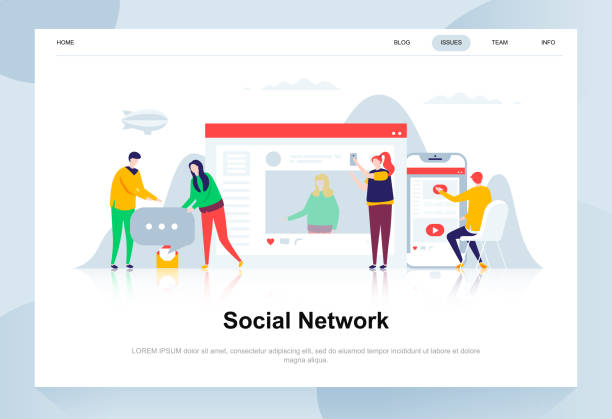Introduction to the Importance of Secure Website Design

In the current digital age, where online activities have become an inseparable part of daily life and businesses, the importance of #Secure_Website_Design is more evident than ever.
A #Secure_Website not only gains user trust but also protects their sensitive information from cyberattacks.
In this explanatory and educational chapter, we will discuss why this issue is vital and its fundamental concepts.
Every website, from a simple personal blog to large e-commerce platforms, has the potential to become a target for malicious attacks.
These attacks can lead to the theft of personal information, financial data, service disruption, and even damage to brand reputation.
Therefore, investing in website security is not an option but a necessity.
Secure website design means implementing a set of procedures, technologies, and standards aimed at protecting the website from cyber threats.
This includes protecting user data, ensuring service accessibility, and maintaining content integrity.
Understanding these basic principles is crucial for anyone intending to launch or manage a website.
This process begins from the initial design stages and continues through ongoing maintenance and updates to provide a secure and stable online environment.
Without sufficient attention to security aspects, any website will be at serious risk.
Are your e-commerce site visitors leaving before making a purchase? Don’t worry anymore! With Rasaweb’s professional e-commerce website design services, solve the problem of not converting visitors into customers forever!
✅ Significantly increase conversion rates and sales
✅ Exceptional and attractive user experience
⚡ Contact us now for a free consultation!
Identifying Common Web Security Threats

To engage in secure website design, we must first become familiar with the common security threats that target websites.
This chapter, specialized and providing necessary guidance, examines the most important vulnerabilities and attacks that web developers and administrators should be aware of.
One of the most common attacks is SQL Injection, where an attacker attempts to access or manipulate the website’s database by inserting malicious code into input fields.
Another very common attack is Cross-Site Scripting (XSS), where malicious client-side codes are injected into web pages, allowing the attacker to access cookies, session tokens, or other sensitive user information.
Cross-Site Request Forgery (CSRF) attacks can also trick users into performing unwanted actions on trusted websites.
In addition, Distributed Denial of Service (DDoS) attacks render the website inaccessible by sending a huge volume of fake traffic.
Other vulnerabilities such as broken authentication, misconfigurations, sensitive data exposure, and the use of vulnerable components also exist, all of which emphasize the importance of a comprehensive approach to secure website design.
Understanding these threats is the first step in preventing and protecting your website.
Secure Coding Methods and Best Practices

Secure website design literally begins from the coding stage.
In this educational and specialized chapter, we introduce the best practices and secure coding techniques essential for reducing potential vulnerabilities in your website.
One of the most important principles is input validation.
All data submitted by the user to the website must be carefully checked and sanitized to prevent attacks such as SQL Injection and XSS.
Using parameterized queries or Prepared Statements for database interaction instead of directly concatenating user inputs into SQL strings effectively prevents SQL injection.
Also, secure session management is crucial; session tokens should be sufficiently complex, transmitted over HTTPS, and have a limited lifespan.
Preventing the disclosure of sensitive information in error messages and logs, implementing appropriate error management mechanisms, and using reputable web development frameworks that have built-in security features (such as input filtering and CSRF protection) are other secure coding methods.
Below is a table of a secure coding checklist that developers can use to ensure compliance with the basic principles of secure website design.
| Row | Security Item | Description |
|---|---|---|
| 1 | Input Validation | Verify and sanitize all user inputs for type, length, and format. |
| 2 | Use of Parameterized Queries | Use Prepared Statements to prevent SQL Injection. |
| 3 | Secure Session Management | Send session tokens encrypted and with limited lifespan. |
| 4 | XSS Prevention | Properly escape user outputs before displaying them in HTML. |
| 5 | CSRF Protection | Use CSRF tokens in sensitive forms. |
| 6 | Error Management | Display generic error messages and save details in logs. |
The Importance of SSL/TLS Certificates in Website Security

One of the main pillars of secure website design is the use of SSL/TLS certificates.
This explanatory and guidance chapter elaborates on the importance of these certificates and how they function in creating a secure communication channel between the user’s browser and the website’s server.
The SSL/TLS protocol (Secure Sockets Layer/Transport Layer Security) encrypts data transmitted between the website and the user.
This encryption prevents eavesdropping, tampering, or forgery of information by third parties.
When a website uses HTTPS (HTTP Secure) instead of HTTP, it means its communications are protected by SSL/TLS.
This is especially critical for websites that exchange sensitive information such as passwords, credit card details, or personal data.
Modern browsers also warn users whether a website is secure or not, and websites without HTTPS are often labeled “not secure,” which can severely negatively impact user trust and the website’s SEO ranking.
Furthermore, search engines like Google prefer websites that use HTTPS in their search results.
Therefore, proper installation and configuration of SSL/TLS certificates are not only a security necessity but also a competitive advantage and a key factor in enhancing user experience and website SEO.
Are you losing customers because of your e-commerce site’s outdated appearance or slow speed? Rasaweb’s expert team solves these problems with professional e-commerce website design!
✅ Increase customer trust and your brand’s credibility
✅ Blazing speed and excellent user experience
Get a free consultation with Rasaweb now ⚡
Server Security and Hosting Considerations

Secure website design is not limited to website coding alone; the security of infrastructure and hosting servers also plays a vital role.
This specialized chapter, providing practical guidance, addresses security aspects related to servers and hosting considerations.
Choosing a reputable and secure hosting provider is the first step.
This provider should have secure physical infrastructure, powerful firewalls, intrusion detection systems, and strong technical support.
Furthermore, correct server configuration is of paramount importance.
This includes disabling unnecessary services, closing unused ports, and using secure protocols for remote access, such as SSH instead of FTP.
Regular updates of the server operating system and its software (such as web server, database, and programming language) are essential to fix known security vulnerabilities.
Using strong and complex passwords for server and database access, as well as implementing multi-factor authentication (MFA) mechanisms, provides an additional security layer.
Additionally, continuous monitoring of server logs to identify suspicious activities and regular data backups for quick recovery in case of security incidents are considered fundamental principles of server security.
All these measures together significantly contribute to the overall stability and security of the website.
User Authentication and Access Management

Within the framework of secure website design, how users are authenticated and their access to various website resources are managed is of particular importance.
This educational and guidance chapter explains the best practices to ensure that only authorized users have access to the desired information and functionalities.
Using strong passwords and strict password policies, including requiring a combination of uppercase and lowercase letters, numbers, and symbols, as well as an appropriate password length, is the first step.
Furthermore, never store passwords in plain text; instead, use one-way hashing functions with appropriate Salt.
Implementing multi-factor authentication (MFA) or two-factor authentication (2FA) provides a stronger security layer, making attacker access difficult even if the password is compromised.
Role-Based Access Control (RBAC) systems ensure that each user only has access to the parts of the website necessary for their tasks.
This embodies the Principle of Least Privilege.
Monitoring user activities and logging unsuccessful login attempts can also help identify brute force attacks or attempted intrusions.
Adhering to these principles in authentication and access management is an integral part of a comprehensive secure website design strategy.
Regular Security Audits and Penetration Testing

After implementing the principles of secure website design, the work is not over.
Websites must be continuously subjected to security audits and penetration tests.
This analytical and informative chapter describes the importance of these periodic activities for identifying and remedying hidden or new vulnerabilities, as well as how to perform them.
Penetration Testing is a process in which security experts, using tools and techniques similar to hackers, attempt to infiltrate the website system to identify weaknesses.
These tests can include White-box tests (with full access to code and infrastructure), Black-box tests (with no knowledge of the system), and Gray-box tests (with limited knowledge).
Regular security audits also involve reviewing source code, server configuration, and security protocols to ensure compliance with standards and best practices.
These activities help websites stay one step ahead of attackers and fix vulnerabilities before they can be exploited by hackers.
Below is a table of common types of security tests used in the process of secure website design and its maintenance.
These measures are an integral part of any comprehensive security program and ensure the long-term stability and protection of the website.
| Test Type | Main Goal | Timing |
|---|---|---|
| Penetration Test | Simulating an attack to discover vulnerabilities | After major development, or annually |
| Vulnerability Scan | Automated identification of known vulnerabilities | Monthly or weekly |
| Code Review | Reviewing source code to find security flaws | During the development process and before deployment |
| Configuration Audit | Reviewing server and software configurations | After any major change or periodically |
Data Privacy and Compliance

In today’s world, where the protection of personal data has become a global concern, secure website design must seriously consider data privacy and compliance with related regulations.
This thought-provoking and explanatory chapter addresses the challenges and requirements that websites face in this regard.
Regulations such as GDPR (General Data Protection Regulation) in Europe and CCPA (California Consumer Privacy Act) in the U.S. have set strict standards for the collection, processing, and storage of users’ personal data.
The question is, is your website ready for these challenges? Non-compliance with these regulations can lead to heavy fines and loss of user trust.
A secure website should adopt a “Privacy by Design” approach, meaning that privacy considerations are taken into account from the very beginning of all stages of website development and implementation.
This includes transparency regarding how data is collected and used, allowing users access to their data, the right to be forgotten, and strong security measures to protect data from breaches or unauthorized access.
Attention to these aspects is not only a legal requirement but also demonstrates the website’s commitment to maintaining security and respecting user privacy.
Does your current corporate website present a worthy image of your brand and attract new customers?
If not, with Rasaweb’s professional corporate website design services, turn this challenge into an opportunity.
✅ Significantly improves your brand’s credibility and image.
✅ Paves the way for attracting new leads and customers.
⚡ Contact Rasaweb now for a free and specialized consultation!
Incident Response and Disaster Recovery Planning

Even with the best approaches to secure website design, the probability of security incidents never reaches zero.
Therefore, having a well-defined plan for Incident Response and Disaster Recovery is crucial.
This specialized and guidance chapter discusses the importance and key components of these plans.
An incident response plan should include steps that the security team must follow if a cyberattack or security breach is identified.
These stages usually include identification of the incident, containment, eradication, recovery, and lessons learned.
The speed of containment can prevent further damage and data loss.
On the other hand, a disaster recovery plan focuses on restoring website functionality to normal after a destructive event (such as data loss, a prolonged DDoS attack, or hardware failure).
This includes having regular and reliable backups of all website data and configurations, as well as an operational plan for rapid system restoration.
Training teams, practicing plans, and continuously updating them based on new threats are essential components of these plans.
By having a comprehensive response and recovery plan, even in the worst-case scenarios, the website can quickly resume operations with minimal disruption and maintain user trust.
The Future of Web Security and Emerging Trends

The world of cybersecurity is constantly evolving, and secure website design must adapt to these changes.
This engaging and analytical chapter examines emerging trends and technologies that will shape the future of web security.
One such trend is the use of Artificial Intelligence (AI) and Machine Learning (ML) in security systems.
These technologies can identify malicious traffic patterns with greater accuracy and automatically respond to threats.
Also, the concept of “Zero Trust” is expanding, where no user or device, whether inside or outside the network, is automatically trusted, and all requests must be authenticated and authorized.
Blockchain technology also has the potential to create new security solutions, especially in areas such as identity management and secure transaction logging.
The increasing use of Serverless Computing and Microservices also brings its own security challenges, requiring new approaches for secure website design.
Given the increasing complexity of threats, collaboration within the security community, information sharing, and continuous innovation in tools and techniques will be essential to maintain the security of the web space in the future.
Frequently Asked Questions
| Row | Question | Answer |
|---|---|---|
| 1 | What is secure website design? | Secure website design is a process in which websites are built with security measures in mind from the initial stages of development to protect against cyberattacks, unauthorized access, and data loss. |
| 2 | Why is secure website design important? | Website security is crucial for maintaining user trust, protecting sensitive information (personal and financial), preventing brand reputation damage, and complying with privacy and security regulations (such as GDPR). A security breach can lead to financial and legal damages. |
| 3 | What are the most common cyberattacks a website faces? | Some of the most common attacks include SQL Injection, Cross-Site Scripting (XSS), Distributed Denial of Service (DDoS), Brute Force, and Credential Stuffing attacks. |
| 4 | What is SQL Injection and how can it be prevented? | SQL Injection is a type of attack where an attacker attempts to manipulate the database or extract information by injecting malicious SQL code into site inputs. To prevent it, you should use Prepared Statements/Parameterized Queries, ORM (Object-Relational Mapping), and strict input validation. |
| 5 | What is Cross-Site Scripting (XSS)? | XSS is a type of attack where an attacker injects malicious scripts (usually JavaScript) into web pages that are then executed by other users’ browsers. This can lead to the theft of cookies, session information, or changes to the website’s appearance. |
| 6 | How can Brute Force attacks on login pages be prevented? | To prevent Brute Force attacks, you should use CAPTCHA, limit the number of failed login attempts (Account Lockout), implement Two-Factor Authentication (2FA), and encourage the use of complex and long passwords. |
| 7 | What is the role of HTTPS in website security? | HTTPS encrypts the communication between the user’s browser and the website’s server using SSL/TLS. This prevents eavesdropping, tampering, or forgery of information during transmission and increases user trust. |
| 8 | What is the importance of Input Validation in security? | Input validation is the process of checking and sanitizing data entered by the user. This prevents the injection of malicious code, XSS attacks, SQL Injection, and other vulnerabilities, ensuring that the data conforms to the expected format. |
| 9 | Why is regular updating of website systems and software necessary? | Regularly updating the operating system, CMS (like WordPress), plugins, themes, and libraries used addresses known security vulnerabilities. Hackers often exploit weaknesses in outdated software for intrusion. |
| 10 | What role do regular backups play in secure website design? | Regular and tested backups of website data (database and files) are a vital layer of defense against information loss due to cyberattacks, human errors, or hardware failures. This enables rapid website recovery in the event of a disaster. |
And other services of RasaWeb Advertising Agency in the field of advertising
Smart Marketing Automation: A novel service to improve SEO ranking through key page optimization.
Smart Digital Advertising: Professional optimization to improve SEO ranking using custom programming.
Smart Data Analysis: Designed for businesses looking to increase click-through rates through custom programming.
Smart Advertising Campaign: A professional solution for digital branding focusing on smart data analysis.
Smart Digital Advertising: Designed for businesses seeking online growth through attractive UI design.
And over hundreds of other services in internet advertising, advertising consultation, and organizational solutions
Internet Advertising | Advertising Strategy | Advertorials
Resources
Website Security ChecklistWebsite SecurityComprehensive Guide to Site SecurityEnhance Site Security
? To elevate your business in the digital world, Rasaweb Afarin Digital Marketing Agency, specializing in SEO, online advertising, and user-friendly website design, is with you to ensure a powerful and lasting presence.
📍 Tehran, Mirdamad Street, next to Bank Markazi, Southern Kazerun Alley, Ramin Alley, No. 6



